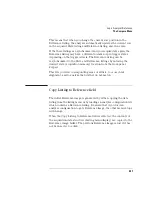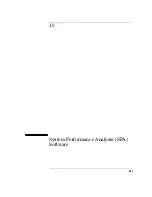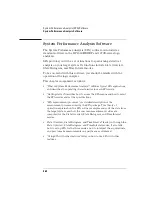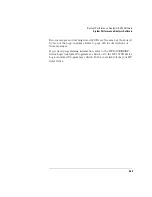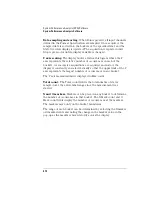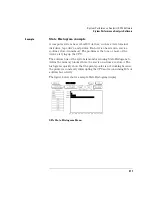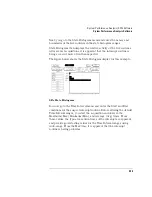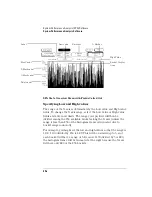
371
System Performance Analysis (SPA) Software
System Performance Analysis Software
Qualified State Histogram and Time Interval modes use all of the labels
in the Format Specification to define either the qualified state or the
start and stop events, respectively. While State Overview and State
Histogram deal with recorded states, Time Interval deals with time.
NOTE:
Changing from one label to another in State Overview or State Histogram
mode or changing the Start or End pattern in Time Interval erases any
configuration and data for the original label. When returning to the original
label, the display returns to its default mode. Loss of configurations and data
when changing between labels can be prevented by saving configurations of
interest to the disk before making the change, or by printing the results.
State Overview mode
State Overview mode is an X-versus-Y chart of the activity on a
specified label. It provides a global view of the distribution of activity of
the target system signals grouped under the specified label.
X axis scaling.
The X axis represents the defined range of the
specified label and is divided into a series of buckets, or smaller ranges.
The range of the X axis is defined by the Low value and High value
fields, and is divided equally among 256 buckets. For example, if the
range defined by the low and high values is 1100, then 1100 divided by
256 equals 4.29. This value will be rounded up to 5, each bucket will
have a range of 5, and only 220 buckets will be used (1100/5 = 220).
The display grid will be truncated on the right because only 220
buckets are displayed.
If the full range of the label or the portion of the label defined by the
Low value and High value is less than 255, then the number of buckets
will be the difference between the Low and High values.
The Low and High values can be specified as discrete values in Binary,
Octal, Decimal, or Hexadecimal. If Symbols have been defined in the
Format Specification, they can also be used for the low and high values.
Summary of Contents for 1670E Series
Page 6: ...6 In This Book...
Page 26: ...26 Contents...
Page 27: ...27 Section 1 Logic Analyzer...
Page 28: ...28...
Page 29: ...29 1 Logic Analyzer Overview...
Page 39: ...39 2 Connecting Peripherals...
Page 49: ...49 3 Using the Logic Analyzer...
Page 72: ...72 Using the Logic Analyzer The Inverse Assembler...
Page 73: ...73 4 Using the Trigger Menu...
Page 101: ...101 5 Using the Oscilloscope...
Page 151: ...151 6 Using the Pattern Generator...
Page 199: ...199 7 Triggering Examples...
Page 237: ...237 8 File Management...
Page 249: ...249 9 Logic Analyzer Reference...
Page 360: ...360 Logic Analyzer Reference The Compare Menu...
Page 361: ...361 10 System Performance Analysis SPA Software...
Page 397: ...397 11 Logic Analyzer Concepts...
Page 430: ...430 Logic Analyzer Concepts The Analyzer Hardware Oscilloscope board theory Oscilloscope board...
Page 439: ...439 12 Troubleshooting the Logic Analyzer...
Page 455: ...455 13 Specifications...
Page 471: ...471 14 Operator s Service...
Page 479: ...479 Operator s Service Troubleshooting Troubleshooting Flowchart 2...
Page 491: ...491 Section 2 LAN...
Page 492: ...492...
Page 493: ...493 15 Introducing the LAN Interface...
Page 497: ...497 16 Connecting and Configuring the LAN...
Page 506: ...506 Connecting and Configuring the LAN Connecting and Configuring the LAN...
Page 507: ...507 17 Accessing the Logic Analyzer File System Using the LAN...
Page 515: ...515 18 Using the LAN s X Window Interface...
Page 527: ...527 19 Retrieving and Restoring Data Using the LAN...
Page 539: ...539 20 Programming the Logic Analyzer Using the LAN...
Page 546: ...546 Programming the Logic Analyzer Using the LAN Programming the Logic Analyzer Using the LAN...
Page 547: ...547 21 LAN Concepts...
Page 555: ...555 22 Troubleshooting the LAN Connection...
Page 580: ...580 Troubleshooting the LAN Connection Getting Service Support...
Page 581: ...581 Section 3 Symbol Utility...
Page 582: ...582...
Page 583: ...583 23 Symbol Utility Introduction...
Page 588: ...588 Symbol Utility Introduction Symbol Utility Introduction...
Page 589: ...589 24 Getting Started with the Symbol Utility...
Page 597: ...597 25 Using the Symbol Utility...
Page 609: ...609 26 Symbol Utility Features and Functions...

